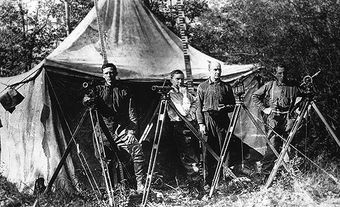Mechanical Engineering
Mechanical Engineering is a branch of ENGINEERING that deals with the design, construction and operation of machines. Machines are designed for an enormous variety of purposes, but most fall into 3 broad categories: energy conversion machines, including engines, heat exchangers, refrigerators, heat pumps, furnaces, motors, brakes, windmills and turbines; manufacturing machinery, including lathes, drills, rolling mills, assembly-line robots and hand tools; and transportation machinery, including all vehicles, conveyors and pipelines, with their compressors and pumps. Mechanical engineering plays a role in the production of all goods and commodities; moreover, many consumer goods (eg, domestic appliances) are machines.
History
Mechanical engineering can be said to have started with the Industrial Revolution, with the advent of the steam engine. It has evolved as advances in materials, control technology and design methods have led to continued improvements in machines of all kinds. The last 3 decades have seen an acceleration of that evolution, as machines continued to become more efficient, faster, more precise, more economical and capable of performing more functions. The growth in industrial uses of computers in the last decade has increased that acceleration even more. Today, it appears that mechanical engineering stands on the threshold of another revolution, the result of the advent of cheap and reliable microelectronic devices, particularly sensors of various kinds and microprocessors.
Canadian mechanical engineers have made many world-class contributions to technology, including self-propelled combines, harvesting equipment for forest industries, pulp and paper production machinery, and hydroelectric turbine generators. More recent achievements include the CANDU nuclear power generating system, the aircraft engines of the PT-6 family developed by Pratt & Whitney Canada, Ltd, the SNOWMOBILES and LRC trains designed by Bombardier, Ltée, and the CANADARM manipulator for the NASA Space Shuttle developed by Spar Aerospace Ltd.
Because mechanical engineering is a very broad branch of engineering, it has developed a number of specialties.
Education and Societies
Technical training in Canada probably began in the workshops of railways, factories and some schools. Formal courses in mechanical engineering followed the establishment of schools and colleges of engineering or practical science in eastern Canada in the late 19th century. Most Canadian universities offer accredited, 4-year degree programs leading to an honours BA. Many offer postgraduate programs leading to the master's and PhD degrees. Among the Canadian universities offering engineering programs are Queen's, Dalhousie, Carleton, Ottawa, Saskatchewan, Toronto, Alberta, British Columbia, New Brunswick, Windsor, Prince Edward Island and Calgary. Degrees and diplomas in mechanical engineering technology, with courses of study ranging from 2 to 4 years, are offered at institutes of technology and at numerous community colleges.
Canadian mechanical engineers have 2 principal professional and technical organizations: the mechanical engineering branch of their provincial engineering association and the Canadian Society for Mechanical Engineering. CSME was founded in 1970 as a constituent society of the Engineering Institute of Canada. Both the provincial associations and CSME hold technical meetings and produce publications containing professional and technical news. CSME also publishes Transactions in which research developments are reported. A biennial technical conference, the Canadian Congress of Applied Mechanics, provides a forum for discussion of current research. Canadian mechanical engineers are also active in many foreign and international technical societies.
See also ENGINEERING, HISTORY OF; IRON RING.

 Share on Facebook
Share on Facebook Share on X
Share on X Share by Email
Share by Email Share on Google Classroom
Share on Google Classroom

